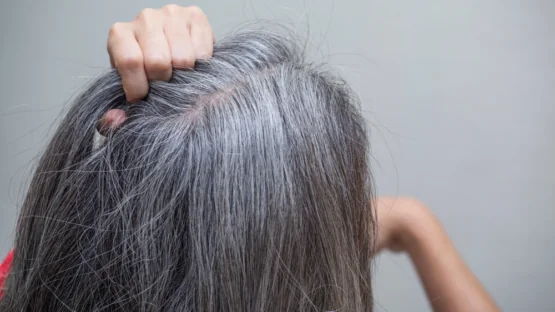Researchers publishing in Nature have made the surprising discovery that pigmentation cells (melanocytes) can naturally transition back into the stem cell state in a process called dedifferentiation.
A kinship with hair follicle cells
These researchers begin their study by discussing stem cells and their proliferation. In the common understanding, which appears to be true for blood cells [1], the human body maintains a stem cell population that divides either into identical stem cells or partially differentiated cells that divide into functional, somatic cells [2].
Hair follicle cells have commonalities with melanocytes. When hair regenerates, both follicle stem cells and melanocyte stem cells act, bringing growth and pigmentation to the hair [3]. Melanocyte stem cells are commonly known to occupy a specific niche, and previous work has suggested that this niche becoming depleted is the key cause of hair whitening. We have previously published an interview with this idea in mind.
However, these researchers disagree with the basic essence of that idea, as their results suggest that the stemlike state of hair pigmentation cells can switch back and forth.
The bulge and the hair germ
This research separately examines the bulge and the hair germ, which are known to be the niches associated with hair pigmentation and growth. This research corroborates previous research demonstrating that melanocyte stem cells can sometimes be found in the bulge [4].
However, according to this study’s volumetric analysis, these cells aren’t usually in the bulge at all; instead, they normally reside in the follicle’s hair germ area. When the mature melanocytes are at the part of the hair cycle when they express pigmentation, the stem cells migrate to the bulge and migrate back before the next cycle. This does not occur with hair follicle cells.
No dedicated stem cell niche
The authors developed a fluorescent reporter to track the fate of cells expressing Oca2, which is associated with differentiated, active melanocytes. This is where they confirmed their key discovery: instead of their reporter gene being gradually flushed as the somatic pigmentation cells went away, the gene was being expressed in cells that were displaying more stemlike charcteristics. Therefore, according to this study, these cells had dedifferentiated from a somatic state into a stem cell state.
Furthermore, after repeatedly administering their reporter and checking for the presence of unreported melanocyte stem cells that never became pigment-producing cells, these researchers discovered no such population group. Therefore, they came to a shocking conclusion: there is no truly dedicated niche that contains a reserved population of melanocyte stem cells.
There is also an explanation for how and why melanocytes decline with aging. Using a population of genetically engineered mice, the researchers found that Wnt signaling is crucial to melanocyte stem cell fate. If Wnt is always on, the cells stay differentiated and die off; if Wnt is off, the cells cannot differentiate and hair turns white. This is in accordance with previous research [3].
Conclusion
The researchers note two different downstream consequences of their findings. Cells that regularly transition back into stem cells appear to be rejuvenative at first glance, but this could cause accelerated aging instead, as these transitory cells aren’t able to protect themselves from damage in the way that a dedicated stem cell population can. The second consequence is considerably more dire: this paper offers at least a partial explanation for the aggressiveness of melanoma, which occurs when out-of-control melanocytes become cancerous.
While this is a mouse study and these findings fly in the face of the widely held understanding of the melanocyte stem cell niche, this was a peer-reviewed study published in a major academic journal, and it certainly warrants further investigation. If these researchers’ results are confirmed to be true in human beings, they may offer an entirely new set of approaches to hair graying with age.
Literature
[1] Seita, J., & Weissman, I. L. (2010). Hematopoietic stem cell: self‐renewal versus differentiation. Wiley Interdisciplinary Reviews: Systems Biology and Medicine, 2(6), 640-653.
[2] Cockburn, K., Annusver, K., Gonzalez, D. G., Ganesan, S., May, D. P., Mesa, K. R., … & Greco, V. (2022). Gradual differentiation uncoupled from cell cycle exit generates heterogeneity in the epidermal stem cell layer. Nature Cell Biology, 1-9.
[3] Rabbani, P., Takeo, M., Chou, W., Myung, P., Bosenberg, M., Chin, L., … & Ito, M. (2011). Coordinated activation of Wnt in epithelial and melanocyte stem cells initiates pigmented hair regeneration. Cell, 145(6), 941-955.
[4] Nishimura, E. K., Jordan, S. A., Oshima, H., Yoshida, H., Osawa, M., Moriyama, M., … & Nishikawa, S. I. (2002). Dominant role of the niche in melanocyte stem-cell fate determination. Nature, 416(6883), 854-860.




